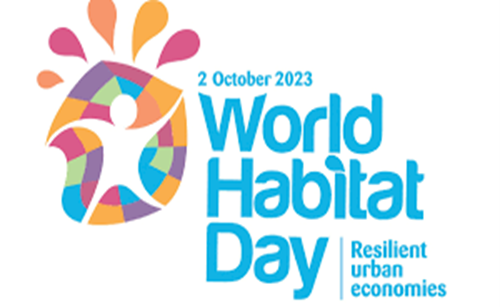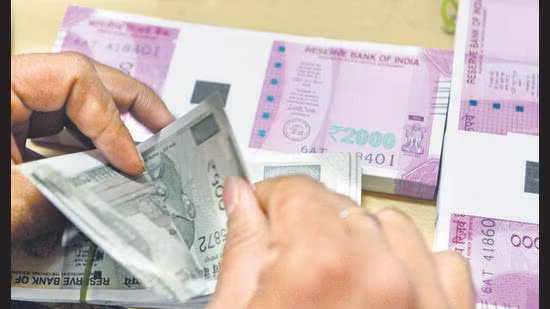- Courses
- GS Full Course 1 Year
- GS Full Course 2 Year
- GS Full Course 3 Year
- GS Full Course Till Selection
- Answer Alpha: Mains 2025 Mentorship
- MEP (Mains Enrichment Programme) Data, Facts
- Essay Target – 150+ Marks
- Online Program
- GS Recorded Course
- Polity
- Geography
- Economy
- Ancient, Medieval and Art & Culture AMAC
- Modern India, Post Independence & World History
- Environment
- Governance
- Science & Technology
- International Relations and Internal Security
- Disaster Management
- Ethics
- NCERT Current Affairs
- Indian Society and Social Issue
- NCERT- Science and Technology
- NCERT - Geography
- NCERT - Ancient History
- NCERT- World History
- NCERT Modern History
- CSAT
- 5 LAYERED ARJUNA Mentorship
- Public Administration Optional
- ABOUT US
- OUR TOPPERS
- TEST SERIES
- FREE STUDY MATERIAL
- VIDEOS
- CONTACT US
World Habitat Day 2023
World Habitat Day 2023

Context
World Habitat Day (WHD) was celebrated on October 2, 2023. With a focus on the progression of urban development, sustainability, and the contribution of cities to economic prosperity, this annual global observance has gone a long way.
What is World Habitat Day?
- About:
- Every year on the first Monday in October, the United Nations declares World Habitat Day as a time to consider the condition of our habitats and everyone's basic right to a suitable place to live.
- The purpose of the Day is also to serve as a global reminder that each of us has the power and responsibility to influence how our towns and cities develop.
- Origin: World Habitat Day originated in Nairobi, Kenya, in 1986. The first celebration's theme was "Shelter is my Right," which addressed the serious issue of insufficient shelter in urban areas.
- Theme 2023: Resilient urban economies. Cities as drivers of growth and recovery.
- Note: The United Nations Human Settlements Programme introduced the UN-Habitat Scroll of Honour Award in 1989. At the moment, it stands as the world's most prestigious human settlements prize.
Role of Cities in Economic Recovery
- Economic Engines:
- Cities are major contributors to a country's GDP, acting as economic engines.
- Urban regions are the economic centers of productivity, producing over 75% of the global GDP. They draw talent, capital, and businesses, which promotes economic expansion.
- Employment Opportunities:
- Cities provide a wide range of employment options, attracting a skilled and diverse labour population.
- Cities have a pivotal role in mitigating unemployment rates and enhancing the general welfare of their residents during periods of economic recovery.
- Innovation and Technology Hubs:
- Many cities are epicentres of technology and innovation.
- They are home to research facilities, academic institutions, and tech firms that drive technical progress and support innovation-led growth, which further promotes economic recovery.
- Infrastructure Development:
- During periods of economic recovery, cities frequently receive significant expenditures in infrastructure.
- In addition to increasing short-term job creation, these expenditures in public utilities, transportation, and services also improve long-term productivity and quality of life.
- Cultural and Creative Industries:
- Cities are home to thriving creative and cultural sectors that support the local economy through design, entertainment, tourism, and the arts.
- In addition to producing income, these industries boost a city's appeal and competitiveness internationally.
What is the Current Urban Landscape in India?
- Status:
- India's economy is among the fastest-growing in the world, and its cities are the main driver of this expansion.
- By 2050, cities are predicted to account for 80% of the country's GDP, up from their current 66% share.
- Current Major Challenges:
- Overpopulation and Rapid Urbanization:
- India is the most populous country in the world, and a sizable number of its people are moving from rural to urban areas.
- The infrastructure and resources of cities are under tremendous strain due to this fast urbanization.
- Inadequate Infrastructure:
- Housing: The increase of slums and informal settlements, where living conditions are frequently subpar, as a result of the lack of affordable housing.
- Water Supply and Sanitation: Many Indian cities struggle to give their citizens access to adequate sanitation facilities and safe, clean drinking water. This causes water bodies to become contaminated and causes health problems.
- Transportation: Congestion, pollution, and longer travel times are all caused by congested roadways and ineffective public transportation networks.
- Environmental Degradation:
- Air Pollution: High levels of air pollution in many Indian cities cause respiratory illnesses and reduce the quality of life for residents.
- Water Pollution: Water bodies are contaminated by sewage, industrial discharges, and inappropriate waste disposal, which has an impact on the environment and public health.
- Inequality and Social Disparities:
- Economic Disparities: The gap between the rich and the poor is widening in India's urban centers due to glaring economic disparity.
- Access to Services: Disparities in well-being and quality of life arise from the fact that many urban dwellers do not have access to fundamental services like healthcare and education.
- Inadequate Waste Management:
- The amount of Municipal Solid Waste generated daily in urban India alone is close to 0.15 million tonnes.
- Nearly 78% of the sewage produced in India is dumped in rivers, lakes, or the ocean untreated, according to the GOI.
- If current laws, programs, and management methods are not sufficiently addressed, the volume of garbage is expected to increase 165 million tonnes by 2031 and 436 million tonnes by 2050.
- Water Scarcity: Many towns are experiencing water scarcity, particularly during dry seasons, as a result of over-extraction of groundwater brought on by urbanization and industry.
- Climate Change Vulnerability: The negative effects of climate change, which can worsen environmental and health problems, are especially likely to affect urban areas. These effects include intense heat islands, flooding, and extremely high temperatures.
Government Initiatives Related to Urban Development
- Smart Cities.
- AMRUT Mission.
- Swachh Bharat Mission-Urban.
- HRIDAY.
- Pradhan Mantri Awas Yojana-Urban.
- Aspirational District Programme.
Way Forward
- Integrated Urban Planning: Comprehensive urban plans that take into account resource balance, climate change resilience, and long-term sustainability are required. encourages sensible growth through zoning rules, effective land management, and mixed land use.
- Innovative Financing for Urban Development: To raise money, cities can investigate cutting-edge financing techniques such as municipal bonds. The government has pushed cities to attract capital investment under the Atal Project for Rejuvenation and Urban Transformation (AMRUT) project.
- Urban Employment Guarantee: For the urban poor to have access to basic living standards, urban areas require a program like MGNREGA. An encouraging move in this regard is the implementation of the Indira Gandhi Urban Employment Guarantee Scheme in Rajasthan.
- Proper Waste Management: Strict waste segregation at the source must be emphasized, and official recycling and composting procedures must be supported. To lessen the impact of garbage disposal on the environment, investments should be made in waste-to-energy technologies and contemporary landfill management.
- Inclusive Development: Prioritizing the needs of marginalized and vulnerable groups is necessary in order to give them access to essential services, first-rate medical treatment, and an education. In the best interests of migrant workers, migrant worker data must be gathered and applied to municipal development initiatives.
Q. With reference to the Indian economy after the 1991 economic liberalization, consider the following statements: (UPSC-2020)
1. Worker productivity (Rs. per worker at 2004-05 prices) increased in urban areas while it decreased in rural areas.
2. The percentage share of rural areas in the workforce steadily increased.
3. In rural areas, the growth in the non-farm economy increased.
4. The growth rate in rural employment decreased.
Which of the statements given above is/are correct?
(a) 1 and 2 only
(b) 3 and 4 only
(c) 3 only
(d) 1, 2 and 4 only
Ans: (b)



